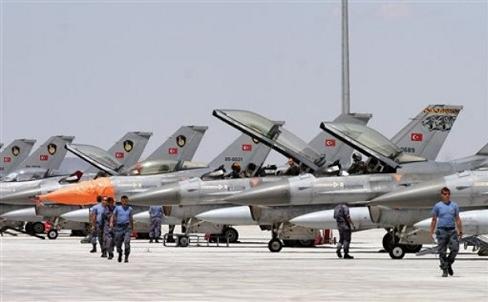Under the terms of a U.S. FMS contract announced in March, Lockheed Martin will provide the Turkish Air Force with electronic warfare modernization on board its fleet of F-16s. The contract, valued at $13.98 million, has a period lasting through the conclusion of December 2017, and will fit the ALQ-211(V)9 Advanced Integrated Electronic Warfare System (AIDEWS) to the jet fighter. However, this is not just an ordinary deal. It is part of an ongoing process, as the U.S. continues to focus on bolstering its allies along the border of the Arabian Peninsula.
In March 2014, Exelis Electronic Systems announced that Turkey had ordered 21 ALQ-211(V)9 AIDEWS pods alongside support equipment and countermeasures dispensing systems. At the time, the contract, if all options were exercised, would be worth a potential $75.3 million. The AIDEWS pods would provide a significant enhancement to the F-16s’ survivability and strike potential.
The ALQ-211(V)9 is the newest generation of the AIDEWS pod. Its capabilities will allow Turkey’s F-16s to sense radar air surveillance from afar, and will provide pilots with flight path redirection in order to avoid detection. Additionally, the V9 is able to act aggressively in the event of radar detection or missile tracking. The EW pod’s onboard jammer and ECM coordinator is capable of disrupting several methods of detection, including RF, IR, and laser; it can also cue the use of chaffs and flares.
What the new EW equipment means is that Turkey will soon be a far more efficient aerial threat. In the event of an aerial battle, the fighter jet now has the capability to unleash some of the latest developments in electronic warfare technology. It contributes to a far greater chance of winning the battle.
Additionally, the Turkish Air Force’s F-16s will now be far more capable in the aerial escort role. The EW upgrade will give the F-16s a far heightened chance of being able to ferry slower moving, more detectable strike platforms into enemy territory; in essence, penetrating deeper behind enemy lines in order to perform crucial ground strikes.
The effective “invisibility” that the ALQ-211(V)9 grants the F-16 gives Turkey a better chance of approaching an enemy in the heart of its territory, so it can hit valuable ground targets. Modernization of Turkey’s AIDEWS pods is somewhat along the lines as last week’s news, when the U.S. finally released Egypt’s F-16s from “delivery hell.” Egypt got the latest version of the fighter jet, with all of the improved aerial surveillance and targeting options that it offers, and the U.S.’s greatest concerns in the area – insurrectionists, ISIS, Iran, etc. – were confronted with a far greater threat in their neighborhood.
It seems to be no coincidence that as the U.S. is in talks with Iran about sanctioning the Middle Eastern nation’s nuclear program it is also enhancing its allies’ border penetration and ground strike capabilities.

In March 2014, Exelis Electronic Systems announced that Turkey had ordered 21 ALQ-211(V)9 AIDEWS pods alongside support equipment and countermeasures dispensing systems. At the time, the contract, if all options were exercised, would be worth a potential $75.3 million. The AIDEWS pods would provide a significant enhancement to the F-16s’ survivability and strike potential.
The ALQ-211(V)9 is the newest generation of the AIDEWS pod. Its capabilities will allow Turkey’s F-16s to sense radar air surveillance from afar, and will provide pilots with flight path redirection in order to avoid detection. Additionally, the V9 is able to act aggressively in the event of radar detection or missile tracking. The EW pod’s onboard jammer and ECM coordinator is capable of disrupting several methods of detection, including RF, IR, and laser; it can also cue the use of chaffs and flares.
What the new EW equipment means is that Turkey will soon be a far more efficient aerial threat. In the event of an aerial battle, the fighter jet now has the capability to unleash some of the latest developments in electronic warfare technology. It contributes to a far greater chance of winning the battle.
Additionally, the Turkish Air Force’s F-16s will now be far more capable in the aerial escort role. The EW upgrade will give the F-16s a far heightened chance of being able to ferry slower moving, more detectable strike platforms into enemy territory; in essence, penetrating deeper behind enemy lines in order to perform crucial ground strikes.
The effective “invisibility” that the ALQ-211(V)9 grants the F-16 gives Turkey a better chance of approaching an enemy in the heart of its territory, so it can hit valuable ground targets. Modernization of Turkey’s AIDEWS pods is somewhat along the lines as last week’s news, when the U.S. finally released Egypt’s F-16s from “delivery hell.” Egypt got the latest version of the fighter jet, with all of the improved aerial surveillance and targeting options that it offers, and the U.S.’s greatest concerns in the area – insurrectionists, ISIS, Iran, etc. – were confronted with a far greater threat in their neighborhood.
It seems to be no coincidence that as the U.S. is in talks with Iran about sanctioning the Middle Eastern nation’s nuclear program it is also enhancing its allies’ border penetration and ground strike capabilities.

